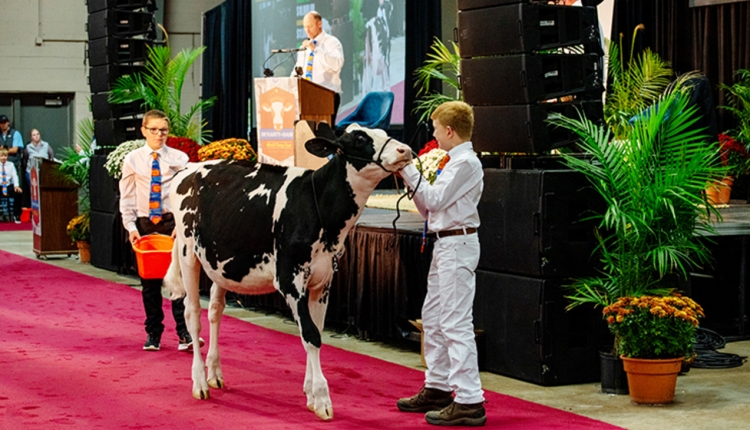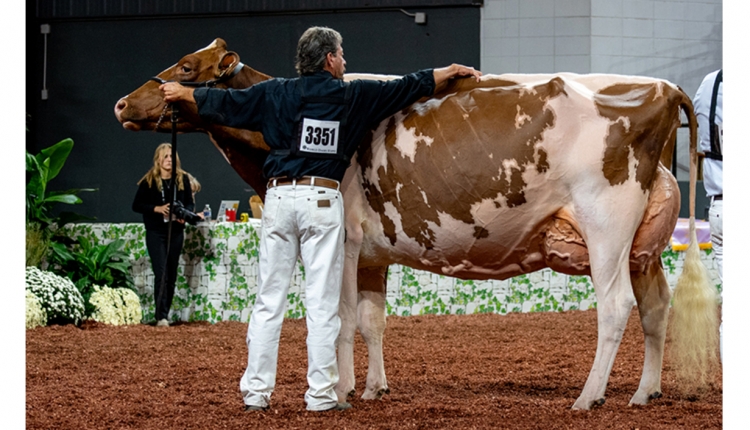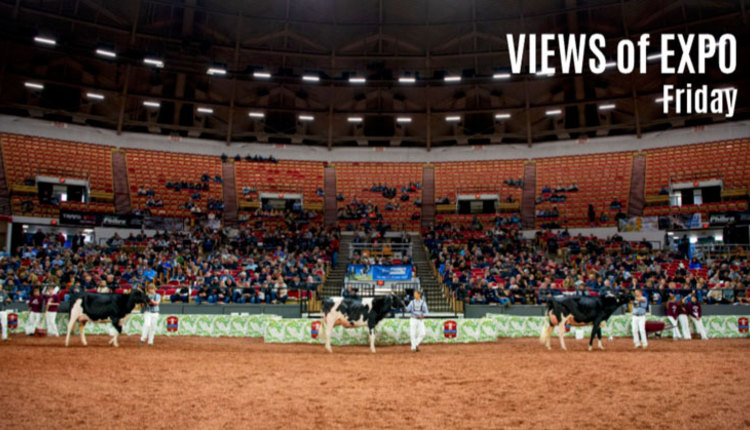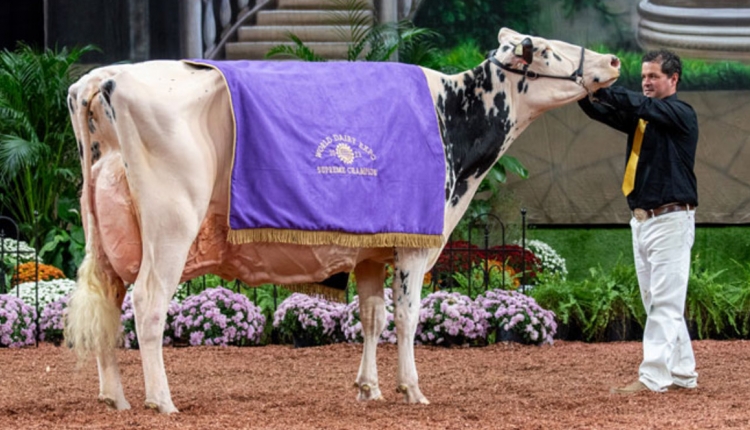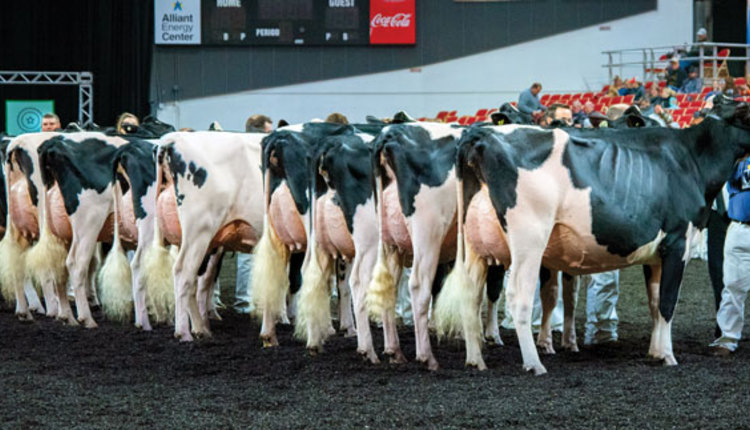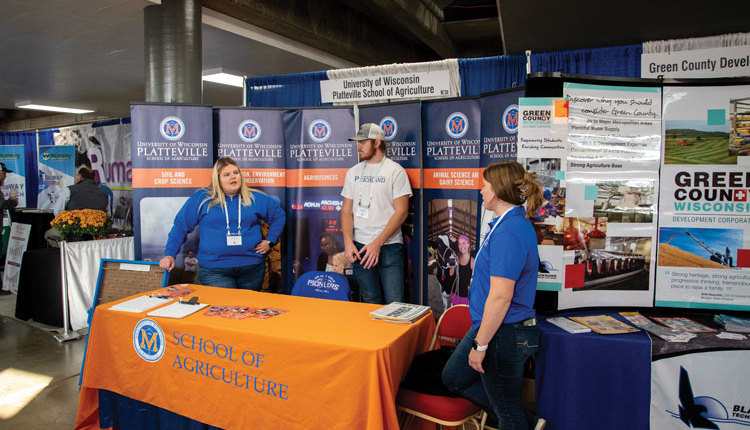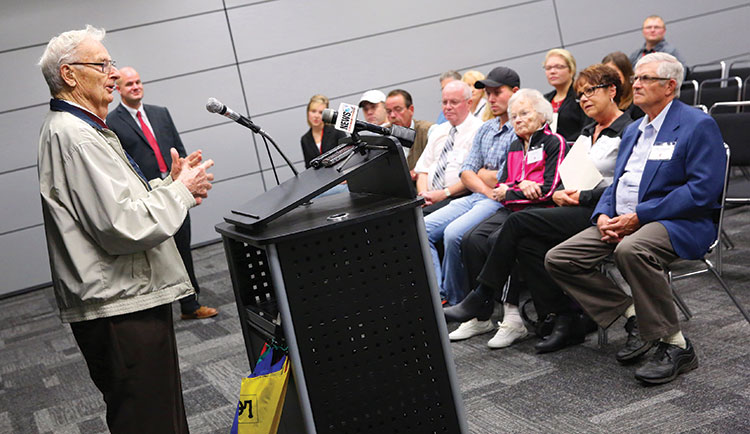
A trade show innovator, Joe Gilbert doubled the exhibit space, created the Commercial Exhibitor Committee, developed curbing to stop water flow through exhibit tents, and even designed the first system for a more orderly procedure for ingress and egress of the new Exhibition Hall.
The trajectory for today’s World Dairy Expo trade show began to take shape under the guidance of Bev Craig, who took over the reins as the World Dairy Expo general manager in 1969. Craig enlisted the assistance of Joe Gilbert, who just happened to be the husband of newly hired Expo staffer Maxine Gilbert.
While Craig retired after 11 years at the helm, Gilbert continued on, serving as the lead volunteer working with commercial exhibits through the early 1990s. In 1987, Gilbert even served as interim general manager after the full-time general manager was badly injured in an auto accident after World Dairy Expo. The very next year, Gilbert teamed up with newly hired general manager Tom McKittrick to double the trade show’s size between 1987 and 1988. We recently caught up with Joe Gilbert to talk more about his long shadow and resulting legacy with the show.
How did your wife, Maxine, become one of the first employees of World Dairy Expo?
It just happened.
Bev and Bettylea Craig were very close friends of ours. Bev had just been appointed as the second executive director of World Dairy Expo.
We went to play bridge with the Craigs . . . and Bev and Maxine got to talking about his new job. He went on to explain “I’ve got to find somebody to become my assistant.”
Maxine said, “Here I am.”
Maxine had just decided to go back to work after our children were in school, and she was looking for a career. Bev jumped at the chance . . . not only because he knew Maxine, but he knew she was an exceptional person. Maxine is very smart and very capable.
How did Bev and Maxine then convince you to help with the trade show?
Bev knew that I had a full-time job, and I was kind of nearing retirement and had vacation time that I could use at Expo time. He wanted to know if I would be able to help during my vacation.
“We don’t have any money, and we don’t have any extra staff to support you. You would be the trade show representative,” is what Bev said.
What kind of person was Bev Craig?
Bev was an ideas man.
He would create ideas and it was up to you to carry them out. He didn’t care whether you could or not; you were expected to pull it together.
Bev was ideal for the job; he was a good salesman. In terms of selling tickets and space, he’d get the idea how that should be done and then you carried it out. “You see a problem, deal with it,” he would say.
It helped that we worked very closely with the board of directors because we were all plotting a course that none of us knew exactly where it would take us. Up to that point, we had no substantial evidence that World Dairy Expo would ever turn out . . . but the board had that vision . . . but those of us who were working at this task could only see mountains ahead of us.
Talk about those show-related mountains.
Here we were moving onto a fairgrounds that had dilapidated buildings in the late 1960s. The barns were rundown because those buildings were slapped together. The thing that did make the grounds attractive was the new Coliseum. If it hadn’t been for that new building, there was nothing that we could use to grow the show long term. We struggled to get the fairgrounds in shape. We had no tools, we had no equipment to handle any kind of hoists or unloading equipment. The fairgrounds did not have a large staff that could be dedicated at the time for World Dairy Expo. We had to rewire the fairgrounds each year to provide electricity out to the parking lot for the large exhibitor tents housing the trade show exhibits. We went on that way for years.
What we needed was money, and that was a big hindrance. The first years were very provincial, very much related to Wisconsin and the surrounding Midwest states. We even prayed for rain so the farmers couldn’t farm and had to come to the show. Of course, our attendance was always up when it rained.
How crucial were volunteers?
When Bev took over the show, it was still a 10-day show. Talk about burning out volunteers. Even so, we had a lot enthusiasm and a lot of people pitched in to help. I recruited some volunteers to help with the trade show. My main job was always with the commercial exhibits and we really needed help in that area in the early years.
How was Madison’s mayor, Henry Reynolds, was he very supportive of the early show?
Mayor Reynolds was just like Bev Craig —sell, sell, and sell. He also was very clever and was a community thinking kind of guy. If it was good for the community, it was also good for Henry.
We had no really good office space at all. We were always begging, borrowing, and stealing space. Henry offered us space in his warehouse where we could set up an office for World Dairy Expo. We did that for two or three years. Mayor Reynolds also owned Reynolds Transfer and Storage. He offered to have booths shipped to his facility, delivered them to the show, and even shipped them back to the vendor free of charge in those early days. Wow, that was really something! He was quite a guy.
How did you become interim general manager for the show in 1987?
By 1987, Bev Craig had retired as executive director, and Brad Rugg had taken over as executive director. At that time, I had been volunteering mostly at Expo time only for many years and routinely took two weeks vacation before and during the show to help out. After that 1987 show, Brad Rugg was involved in a bad car accident and we were in a bind.
Professor Jim Crowley came to me and asked, “Would you be interested in closing out the 1987 show as interim general manager?”
I said, “How can I close it out? I don’t know all the interworkings.”
“Just get it done,” Jim said.
Doc Jim went on to say that he would close out the cattle show as he served as dairy cattle superintendant and that “you close out the rest of the show.” That included finalizing contracts and settling bills.
How did your role as the commercial exhibitor coordinator evolve?
I had to start laying out and taking orders for the spaces for the 1988 show and keep the thing rolling. I took on a lot more duties in that respect such as laying out the outside exhibit spaces, ordering the tents, and making sure that we had enough space for all the exhibits we sold. I was in charge of that whole commercial exhibit area.
How did you help get the trade show on solid footing?
World Dairy Expo hired Tom McKittrick next as general manager. Tom was one heck of a leader. He was born to be a leader.
Tom came aboard in July 1988. He went around and got to know the people, and he came into my office and said to me, “What do you do?” So I filled Tom in.
Tom responded, “Well now, we’ve got to put some zip into this show. No more order taking on the trade show. Potential exhibitors will not be contacting us, we’re going to contact them.”
I said, “I am not a salesperson.”
He said I was about to become one because “you’re now the sales manager.”
I was concerned. “I don’t know how to handle this; you’re setting me up to fail,” I said.
He said “No, I’m not. Tomorrow morning I’ll see to it that you get on your way.”
So the next morning he came in with a whole stack of magazines. He said, “There’s a hundred-plus ads in those magazines. Go ahead and start calling them.”
So I got on the phone and made some calls. All of sudden, we began to get some orders resulting from those phone calls. I sold, sold, and sold.
That’s when World Dairy Expo started to get some financial traction because of substantially increased income. That was a big year . . . in 1988 we doubled the space, going from some 300 spaces to over 600 booths that year.
Tell us about some of your innovations for the show.
We had the problem of all those outdoor trade show tents before the new Exhibition Hall. If it rained, the rain would come down, hit the barns, run off, travel to the manure storage, and continue through the tents where these exhibitors were trying to sell. It was a mess, and we needed an immediate fix. The solution? It involved 6 to 8 inches of asphalt curbing. We needed it installed immediately.
Dane County gave us a very reasonable price . . . we could not afford the curbing when considering our budget. That curbing solved the problem. As a memento of that quick decision, World Dairy Expo still has my “retirement present” . . . a piece of that curbing with a plaque on it.
The other innovation involved the new Exhibition Hall. Everybody wanted to get out quickly on the show’s last day. Further, exhibitors wanted to come and drop off their exhibits at the front end of the show on the docks.
How did you accomplish this quick move in and move out?
Maxine and I had gone on vacation to Newfoundland, Nova Scotia, and back to Maine via a big car ferry. We had a 35-foot fifth-wheel and pulled down into this loading area where all these trucks, vans, and other vehicles were quickly loaded. I watched to see how staff loaded that ship so quickly; it loaded in about a half hour with close to 1,000 vehicles. They accomplished that by forming four lines. I thought to myself that should work for World Dairy Expo and the new exhibit building . . . Exhibition Hall.
I visualized the new Exhibition Hall dock area and quickly concluded that such a plan would work there. It simply was done by forming five lanes leading up to the dock from the parking area and dedicating a lane each to large semis, smaller trucks and vans, and finally passenger cars. Using volunteers who had helped me previously, they formed a team at the entrance, and would, with help from Dane County police, help direct traffic, unload on the dock, and then have the vehicle leave for the parking area. That worked very well.
How did the Commercial Exhibitor Committee get its start?
I helped form the Commercial Exhibitor Committee — that’s another legacy. I found out quickly that as we grew, good communications would certainly enhance the operation. I went to Tom McKittrick and talked to him about it. The committee was formed. I asked Dean Hormsdorf to chair it, and he chairs it to this very day. He is a great leader!
Dean is a good communicator and made no unreasonable demands. Things got done under Dean, things were improved with his help because commercial exhibitors had a voice.
The committee chairmanship has grown to the point where it has a permanent seat on the board and the Executive Committee.
Why did you give so freely of your time to World Dairy Expo?
Bev Craig had that volunteer spirit, it was how World Dairy Expo got started from day one. The Craigs were close friends of ours.
As time went on, I got to know and work alongside many people. Professor Jim Crowley Sr., Art Nesbitt, Greg and Laura Blaska, and Dave Dickson.
It was another world, I guess you could say, that I lived in and I loved it. There was no glory in it. No one ever came and shook your hand and said, “Geez, you did a great job or gee, you sure blew it.” The board always trusted me and my efforts and that was my reward. I enjoyed doing it, and I enjoyed seeing Expo grow. That was a great year (1988) when we got some traction and we got some money to work with. We ultimately gained support from the Dane County employees who helped with the show.
What do you think about today’s show?
It has developed into everything that the founders could have ever dreamed in the early days. The new pavilions really have elevated the show, too. It’s a Class A venue. And there isn’t much left of those old fairgrounds anymore.
